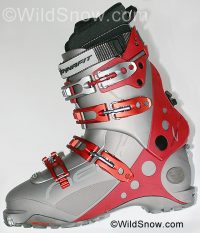I got curious. How exactly is a Dynafit toe fitting held in a boot, how easy is it to remove, and how much does it weigh? On the alter of blog I sacrifice a worn out pair of Scarpa Laser backcountry skiing boots:
 |
| The Dynafit toe fittings are easy to remove. Just grind the sole off, grind away a bit of plastic around the edges, and the fitting pops out when you pry it up. |
 |
| Dynafit fittings removed from boot. Weight 1.1 ounces (32 g) total, per boot. (Coin for scale). |
People have had mixed success with installing Dynafit fittings themselves. In mine and many other people’s opinion, there are so many great Dynafit compatible boots out there, why spend the time to make them yourself? But then, who am I to judge other backcountry skiing modders? If you’re curious, here is the article written by one guy who did it.
WildSnow.com publisher emeritus and founder Lou (Louis Dawson) has a 50+ years career in climbing, backcountry skiing and ski mountaineering. He was the first person in history to ski down all 54 Colorado 14,000-foot peaks, has authored numerous books about about backcountry skiing, and has skied from the summit of Denali in Alaska, North America’s highest mountain.





